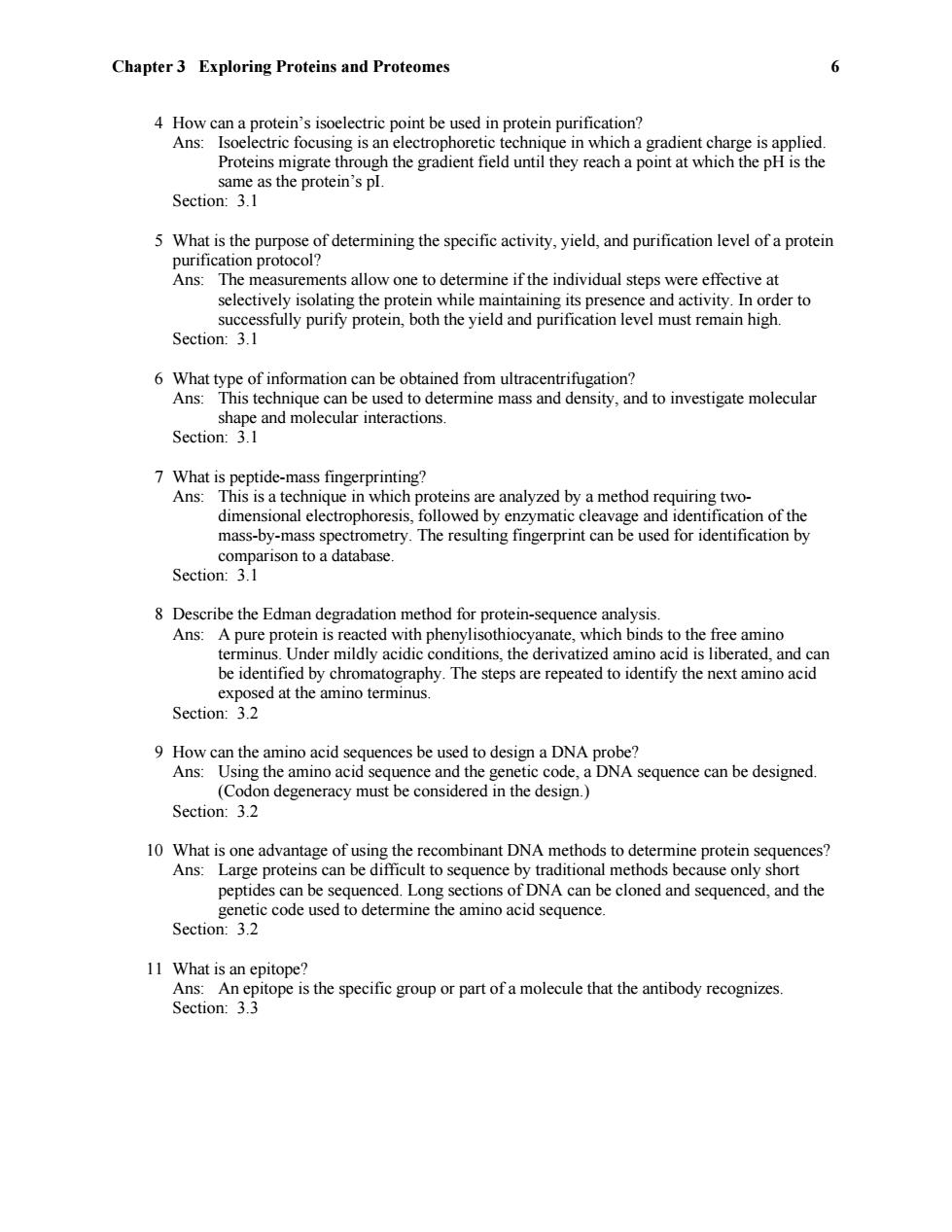正在加载图片...

Chapter 3 Exploring Proteins and Proteomes 6 4 How can a protein's isoelectric point be used in protein purification? Ans:Isoelectric focusing is an electrophoretic technique in which a gradient charge is applied. Proteins migrate through the gradient field until they reach a point at which the pH is the same as the protein's pl. Section:3.1 5 What is the purpose of determining the specific activity,yield,and purification level of a protein purification protocol? Ans:The measurements allow one to determine if the individual steps were effective at selectively isolating the protein while maintaining its presence and activity.In order to successfully purify protein,both the yield and purification level must remain high. Section:3.1 6 What type of information can be obtained from ultracentrifugation? Ans:This technique can be used to determine mass and density,and to investigate molecular shape and molecular interactions. Section:3.1 7 What is peptide-mass fingerprinting? Ans:This is a technique in which proteins are analyzed by a method requiring two- dimensional electrophoresis,followed by enzymatic cleavage and identification of the mass-by-mass spectrometry.The resulting fingerprint can be used for identification by comparison to a database. Section:3.1 8 Describe the Edman degradation method for protein-sequence analysis. Ans:A pure protein is reacted with phenylisothiocyanate,which binds to the free amino terminus.Under mildly acidic conditions,the derivatized amino acid is liberated,and can be identified by chromatography.The steps are repeated to identify the next amino acid exposed at the amino terminus. Section:3.2 9 How can the amino acid sequences be used to design a DNA probe? Ans:Using the amino acid sequence and the genetic code,a DNA sequence can be designed. (Codon degeneracy must be considered in the design.) Section:3.2 10 What is one advantage of using the recombinant DNA methods to determine protein sequences? Ans:Large proteins can be difficult to sequence by traditional methods because only short peptides can be sequenced.Long sections of DNA can be cloned and sequenced,and the genetic code used to determine the amino acid sequence. Section:3.2 11 What is an epitope? Ans:An epitope is the specific group or part of a molecule that the antibody recognizes. Section:3.3Chapter 3 Exploring Proteins and Proteomes 6 4 How can a protein’s isoelectric point be used in protein purification? Ans: Isoelectric focusing is an electrophoretic technique in which a gradient charge is applied. Proteins migrate through the gradient field until they reach a point at which the pH is the same as the protein’s pI. Section: 3.1 5 What is the purpose of determining the specific activity, yield, and purification level of a protein purification protocol? Ans: The measurements allow one to determine if the individual steps were effective at selectively isolating the protein while maintaining its presence and activity. In order to successfully purify protein, both the yield and purification level must remain high. Section: 3.1 6 What type of information can be obtained from ultracentrifugation? Ans: This technique can be used to determine mass and density, and to investigate molecular shape and molecular interactions. Section: 3.1 7 What is peptide-mass fingerprinting? Ans: This is a technique in which proteins are analyzed by a method requiring two- dimensional electrophoresis, followed by enzymatic cleavage and identification of the mass-by-mass spectrometry. The resulting fingerprint can be used for identification by comparison to a database. Section: 3.1 8 Describe the Edman degradation method for protein-sequence analysis. Ans: A pure protein is reacted with phenylisothiocyanate, which binds to the free amino terminus. Under mildly acidic conditions, the derivatized amino acid is liberated, and can be identified by chromatography. The steps are repeated to identify the next amino acid exposed at the amino terminus. Section: 3.2 9 How can the amino acid sequences be used to design a DNA probe? Ans: Using the amino acid sequence and the genetic code, a DNA sequence can be designed. (Codon degeneracy must be considered in the design.) Section: 3.2 10 What is one advantage of using the recombinant DNA methods to determine protein sequences? Ans: Large proteins can be difficult to sequence by traditional methods because only short peptides can be sequenced. Long sections of DNA can be cloned and sequenced, and the genetic code used to determine the amino acid sequence. Section: 3.2 11 What is an epitope? Ans: An epitope is the specific group or part of a molecule that the antibody recognizes. Section: 3.3